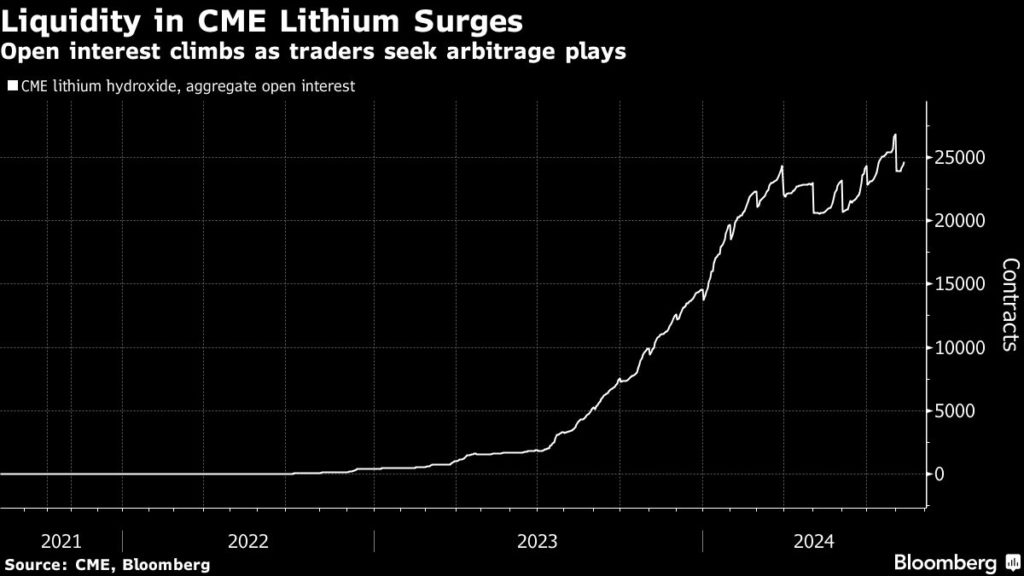
Liquidity in CME Group Inc.’s lithium contracts is on the rise again, with financial players looking to benefit from arbitrage opportunities in the market that’s key to the energy transition.
Open interest, a measure of market participation determined by the number of outstanding contracts, has continuously hit record after record since April. The exchange said its data show that the gauge rose to an all-time high topping 27,000 contracts in early August.
This year’s strong growth builds on the robust liquidity of 2023, which was driven by the lucrative price-differential trade between the lithium carbonate contract on China’s Guangzhou Futures Exchange and the CME’s lithium hydroxide contract. Both lithium hydroxide and carbonate are chemical forms of the battery metal used for electric vehicles.
“Liquidity brings in liquidity,” said Jack Nathan, head of battery materials at broker Tullett Prebon. Financial players such as funds “always look for liquid markets to implement strategies,” he said.

There was also a big increase in total open interest in the CME’s other lithium contract — a carbonate contract launched in July 2023. Still, that market remains small compared with the hydroxide contract.
The rise in open interest in CME’s two lithium contracts has also allowed financial players to look for arbitrage opportunities between the two, according to Leon Hoffmann, a broker at SCB Environmental Markets in Switzerland.
The robust growth in liquidity in CME’s two lithium contracts comes as the Chicago-based bourse has been pushing to take on the London Metal Exchange in battery metals as the latter wades through the fallout of the nickel crisis in 2022 and western sanctions on Russian metals. In cobalt, another key battery metal, while total open interest and volume have slowed this year, CME’s cash-settled cobalt metal contract has grown sharply since its inception in December 2020. Meanwhile activity in the LME’s longstanding physical contract has ground to a halt.
To be sure, liquidity in the two lithium contracts on the Chicago-based bourse still pales against derivatives contracts in more mature markets such as copper. And trading volume in CME lithium has seen a recent dip.
July total trading volume stood at 8,458 contracts, a decline of 1.8% from June, according to CME. Still, in the first seven months of the year, total trading volume was 46,337 contracts, more than double the volume in all of 2023, according to the exchange. As of Aug. 9, total volume stood at 1,876 contracts for the month.
Global lithium prices have been stuck in a prolonged slump thanks to slower-than-expected EV demand and a supply glut. The weakness in prices was more pronounced in top consumer China last year, which led to the Guangzhou carbonate contract trading at a big discount to the CME hydroxide contract.
Now, the price difference between China and the CME has started to narrow, with the EV slowdown intensifying in some Western markets.
“The focus has now shifted toward trading based on market fundamentals,” said SCB’s Hoffmann. Funds and other financial players were mostly shorting lithium on the CME as the battery metal market is expected to remain in a surplus in the next couple of years, although some participants are slowly going long as they see prices bottoming out, according to Hoffmann.
(By Yvonne Yue Li)
Comments